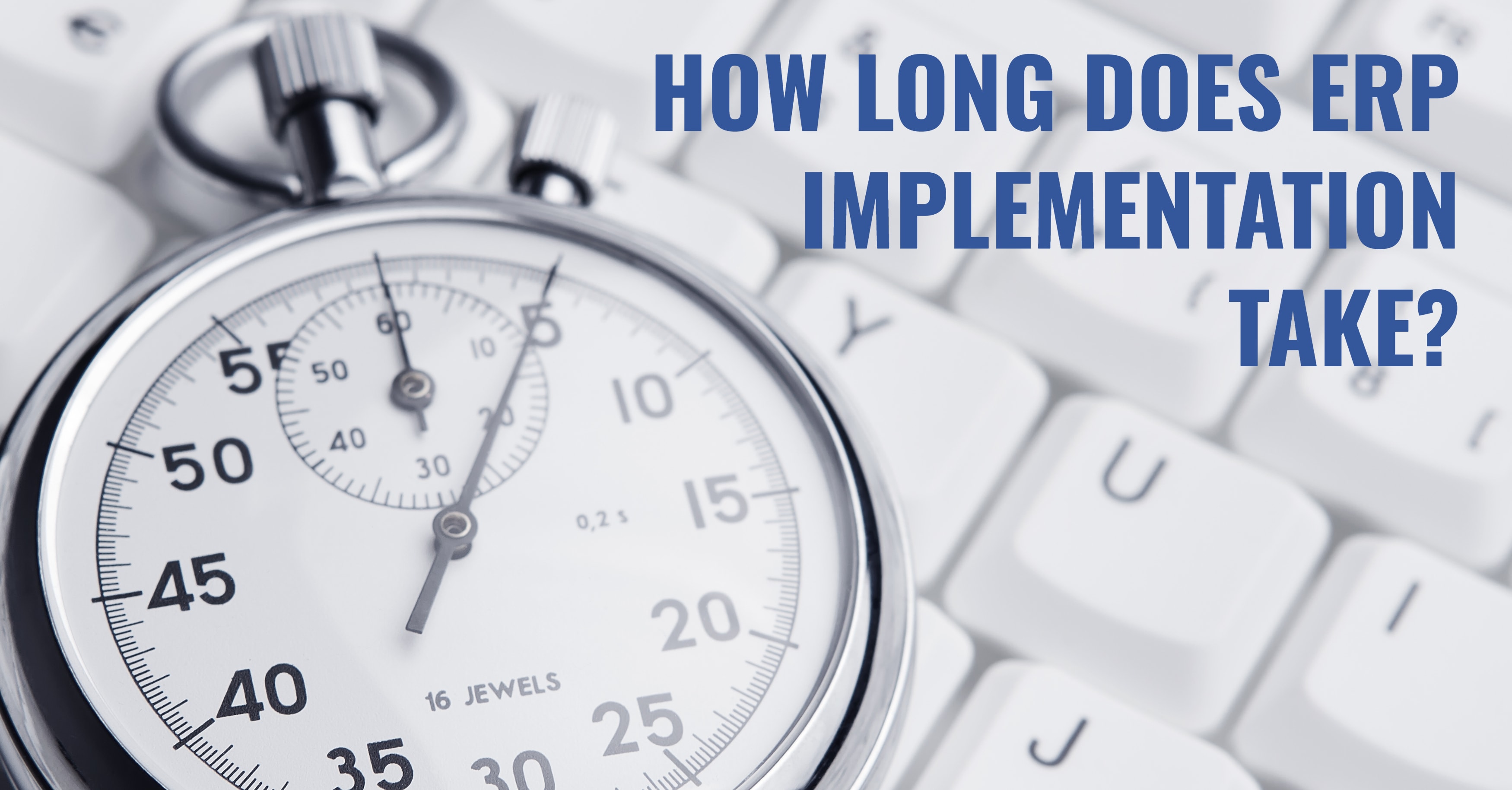Guide to Determining ERP Project Duration
An ERP implementation is a major project, requiring organizations to invest substantial time and resources to ensure the new software will create tangible ROI. As you might expect, the answer to our titular question is not fixed. The length of time it takes to implement your Epicor® ERP instance depends on a number of variables. Determining how long it will take to complete the project is no easy task, but it must be done as accurately as possible. Wrongly estimating the go-live date could result in an impossible schedule that ultimately costs your business more time and money. No pressure, right?
But putting together your ERP timeline can and must be done. To offer some insight into this issue, we spoke to one of Datix’s ERP consultants, who has been working with enterprise software since 1992. Here, he explains how businesses can go about setting a realistic calendar for their Epicor® implementation. His ERP expertise can make the difference between success and failure for your upcoming project. Let’s get some answers:
Q&A:
Q. So, how long do ERP implementations really take?
A. It really depends on your business. Determining the time it will take to implement business software as large and complex as ERP varies from case to case. It can take anywhere from a couple months to a couple years. Implementation time is contingent upon the number of desired modules, available resources and deployment locations as well as customization and data conversion.
Q. What is the process for determining a time estimate?
A. You’ll want to determine how well each of those elements I just mentioned match your business processes. Each have an impact on time. A company also needs to define the type of reporting and dashboard capabilities it will need and determine if there are custom reports that will need to be configured within the ERP system.
Additionally, you should present an exact number of business users to allow the implementation team to identify added complexities. Each of those users will need to be trained on the new system. Your business should utilize an experienced partner who can ensure all user tasks are completed on time.
Q. How soon can a company expect to go live?
A. This is a question many forget to ask on the front end of the project, but it should be a driver of what they’d like to accomplish throughout the implementation and not something contemplated when validating the system.
The only way to have expectations is to build them from the ground up within your company. Integrate an effective communication plan into each phase of the implementation project. This involves weekly status meetings between the project committee and the implementation team from the date the project kicks off. Both the implementation team and the project committee must come to terms with realistic expectations about the project and agree upon priorities.
Key stakeholders in the project must also be appointed a role and held accountable for fulfilling their duties (i.e., executive sponsor having weekly communication with the project committee). With these behavioral aspects of the project in place, the risk of scope creep is greatly reduced.
Q. Is there a difference in deployment time for cloud versus on-premises ERP systems?
A. Yes. On-premises systems require the procurement and setup of hardware (i.e., desktop computers, servers, etc.) and for that reason take a much longer time to implement. There is no way to measure the amount of time it may take for a vendor to supply an ample amount of hardware, but while waiting for hardware, users can begin to learn about the system so they have something to look forward to while they wait. On the other hand, cloud-led technology can be accessed from virtually anywhere a wireless network is present and needs no added procurement of hardware.
Q. Who is in charge of determining the length of time?
A. The team performing the implementation should schedule the project. Sometimes our clients have business reasons for completing the project by a specified date. For those cases, the implementation partner should have an idea of what work can be done by that point. From there, clients and partners can determine which goals are a priority and which are secondary.
The partner should also submit a case to the client as to how the project can be broken up into phases. This way the company can have a realistic expectation about what it will take to complete the project in the way they intended.
Q. What are some red flags that the project time will surpass the initial go-live date?
A. If business leaders aren’t discussing the implementation with the project manager at least weekly, neither party will be held responsible for ensuring milestones are met. Also, if the IT department is the only team engaged in the project, this can cause problems. IT teams understand technicalities, not how to gauge and resolve contingencies in business processes. This is where business leaders from all departments will need to be held accountable for participating in the adoption of the ERP system.
Also, to convert data, it must be free of erroneous spreadsheets and duplicate data. When data is clean, the company can move forward on a reliable system. However, without deciding which data is truly important and which is not, converting this data will elongate the implementation process. Migrating data and converting it takes time—and time is money. The more data that needs to be migrated or converted, the longer the implementation will take. On a side note, if data is unclean, the client can absolutely not upgrade their data. That goes for whichever vendor they work with.
Users must be adequately educated on their system and the processes in which they’ll perform each day. Their education starts at the project’s inception. An implementation partner should require users to review materials about the ERP software as homework. These documents explain the purpose of the system, their role in using it and its importance for their business. This homework keeps users engaged with the system and ensures the most ROI out of the system too, since users are utilizing the system as intended.
Q. What conditions have to be met for a successful ERP implementation?
A. First, a company will need to carve out clearly defined business processes. This involves conceptualizing the workflows of selling, engineering and shipping processes from quote to cash. If business processes are not clearly defined prior to the project, the implementation team will fail to consider these aspects of the business in the mapping of the system. During the validation stage, partners will find that users aren’t performing tasks as they expected, requiring modifications to the system and elongating the project.
Secondly, those designated a role in the project need to be held accountable for completing the tasks they’ve been issued on time. Without managing this, the implementation will inevitably take longer than expected. Users will need to stick to a homework plan throughout the implementation and executive sponsors will be accountable for making sure users are reviewing the material. Also, if there are unique selling or quoting processes the company would like to perform, they’ll need to voice all that information at the front end of the project to properly estimate a realistic time frame for implementation.
Thirdly, your business must choose customizations carefully. The software probably won’t completely fit your business out of the box, but you should only pursue customizations that are required to meet your most important objectives. Any other customizations can wait until after your ERP has been fully implemented. Also, if an integration between your ERP and another system needs to be configured, this will also add a little more time to your project. Though they might make the time frame of your implementation longer than expected, customizations and integrations will increase ROI, more than making up for that extended deadline.
Q: When is a bad time to go live?
A. A client should never expect to go live or begin a project on January 1st. Many companies look to go live by January 1st in order to curb renewal fees of their former system, but this is an unrealistic date because an implementation is too much to take on during periods of heavy business. Your business should be working on its ERP implementation much sooner—say late Q1 or early Q2—in order to meet your expected go-live date and be fully functional in time to meet demands of your peak season.
Wrap Up
Ultimately, businesses that diligently map the project in the beginning will be best equipped to deal with the ebbs and flows of an ERP implementation. This means understanding project goals, creating realistic expectations, and fully grasping what the software can and can’t do prior to creating any deadlines.
For ERP implementation advice, contact our consultants today! Datix has the ERP expertise you need to successfully roll out your new system on time and on budget. From start to finish, our team is dedicated to transforming your business through software.



